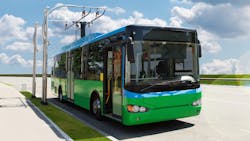Doubling the Number of Electric Transit Buses on the Nation’s Roads
Download this article in PDF format.
The number of electric transit buses transporting people on America’s roads could soon double. This month, the U.S. Department of Transportation's Federal Transit Administration (FTA) announced the availability of $1.66 billion in grants that transit agencies, territories and states can use to increase the size of their electric bus fleets and build facilities for these vehicles.
The grant is being funded through the President’s Bipartisan Infrastructure Law. According to the FTA, more than 1,100 of the buses will use zero-emissions technology, which reduces air pollution and helps meet the goal of net-zero emissions by 2050.
According to the FTA, this round of funding will nearly double the number of no-emission transit buses on America’s roadways. For the first time, it says that 5% of low- and no-emission bus funding will be used to train transit workers on how to maintain and operate new clean bus technology.
“With today’s awards, we're helping communities across America – in cities, suburbs, and rural areas alike – purchase more than 1,800 new buses, and most of them are zero-emission,” US Transportation Secretary Pete Buttigieg, said in the FTA press release. “Funded through President Biden’s Bipartisan Infrastructure Law, this announcement means more good jobs for people across the country, cleaner air in our communities, and more affordable and reliable options to help people get to where they need to go.”
Spreading the Love
Made under FTA’s Buses and Bus Facilities and Low- and No-Emission Vehicle programs, the bus grant awards are the agency’s first competitive grant selections under the Bipartisan Infrastructure Law. The programs support the Biden-Harris Administration’s commitment to expand U.S. transportation infrastructure, create and maintain good-paying jobs, and fight climate change.
The Bipartisan Infrastructure Law provides $5.5 billion over five years for the Low-No Program—more than six times greater than the previous five years of funding. For Fiscal Year 2022, approximately $1.17 billion was available for grants under this program.
Some of the projects selected to receive the funding include the New York Metropolitan Transportation Authority’s purchase of approximately 230 battery-electric buses to replace older diesel buses; the Los Angeles County Metropolitan Transportation Authority’s purchase of approximately 160 battery-electric buses to replace older compressed natural gas buses; and the Memphis Area Transit Authority’s new $54 million electric bus operations and maintenance facility.
Nearly 700,000 Units Worldwide by 2027
As organizations and governments worldwide shift over to more environmentally friendly transportation options, electric buses are gaining in popularity. According to ResearchandMarkets.com, the global electric bus market size is projected to grow from 112,041 units in 2022 to 671,285 units by 2027. Some of the market’s key growth drivers include advancements in battery pack technologies and electric powertrains.
“Many countries are focusing on electrification of their mass transit solutions, especially buses and coaches,” the research firm states. “Factors such as rise in pollution and environmental hazards, stringent government regulations, and stiff competition have compelled automotive OEMs to make fuel-efficient and environment-friendly buses.”
The benefits don’t end there. Electric vehicles also don’t emit noise, offer smoother rides for passengers and allow them to recharge their electronic devices—either at bus stops or on the vehicles themselves. “Electric buses also make sense in operational terms,” energy solutions provider Enel X points out. “Even if the initial costs of switching to an electric fleet can be high, as a lot of charging infrastructure is required, but this investment can be offset by long-term savings in other areas.”
Electric buses are also extremely efficient and have lower operating costs than diesel buses. Fuel savings can be significant when comparing electricity with diesel, and the buses also have fewer moving parts and maintenance needs, energy consultancy Advanced Energy notes. “Between fuel and maintenance savings,” it adds, “they can save hundreds of thousands of dollars over their lifetimes that can be invested back into the operating organization or community.”






